About 15 years ago, a good friend and I performed a ritual to appeal to Hekate for help. We set up an altar in her backyard and, before we began, a fluffy black cat carrying a dead rat entered the yard. The cat approached the altar, dropped the rat next to it, and left. We’d never seen that cat before and never saw it again. The ritual was successful, and Hekate has remained an important goddess in my pantheon since then.
I don’t remember when I first learned about Hekate. One of my earliest exposures to her was when I was about 12 years old. Through a Scholastic Book Clubs flyer, I bought Gods, Demigods & Demons: An Encyclopedia of Greek Mythology by Bernard Evslin, originally published in 1975. Below is the entry on Hekate (yes, I still have it):
“Hecate (HECK uh tee): A goddess of the underworld. Some say she was an aspect of Persephone, Hades’ queen, in her most deadly phase. But she is usually depicted as a self-sufficient deity, very ancient, very cruel… a torturer of ghosts and mistress of the brass-winged, brass-clawed Furies, whose task it is to torment those who have offended the gods. She was known also as queen of the roads, because, in ancient times, the dead were taken beyond the city walls and buried along the side of the roads. Hecate’s cult outlived those of all the other Greek gods. She was adopted by the medieval witch covens as their patroness and was worshipped in their secret rites.”
Interesting, right? It goes a little off the rails, but 12-year-old me must have been fascinated.
I have a shrine to Hekate, and I perform a monthly ritual to her, my adaptation of the Deipnon. This year, I’ve been dedicating every month to a different goddess, and I’ve placed Hekate on my main working altar in October.
It’s spring here in the Southern Hemisphere. Although I’m enjoying waking up to squawking birds, warmer days, and the beautiful Banksia Rose blooming in our backyard, I still associate October with Samhain and ancestors. As I wrote about recently in Happy Equinox, I mix up all my Sabbats now, but spring, like autumn, is a time of transition and just as good for spending time with Hekate, a goddess of liminality.
I have a shrine to Hekate, and I perform a monthly ritual to her, my adaptation of the Deipnon. This year, I’ve been dedicating every month to a different goddess, and I’ve placed Hekate on my main working altar in October.k
Approaching the subject of Hekate
Who is Hekate? What are her functions? How do we worship her? I see people ask these questions every day. Since I’m dedicating this month to Hekate, in a series of articles, I’ll share my understanding of this ancient and mysterious goddess, how I approach her, and where you can learn more.
Keep in mind that Hekate is ancient and was widely worshipped. Her cult had local variations, and the literature about Hekate spans two thousand years. Many contemporary books and papers have been written about Hekate. My scope here is limited to summarising what I think are some of the most important things to know about this complicated goddess when you’re starting to get to know her.
Because of Hekate’s long, complex, and diverse history, she can seem enormous when we learn about her today, like a goddess of everything. This leads to a tremendous amount of variety in approaches in contemporary perspectives and worship.
Origins
Hekate is commonly said to be a Greek goddess, but classical scholars dispute her origins. She may have originated in Thrace, a geographical and historical region in Southeast Europe, now split among Bulgaria, Greece, and Turkey.
Another popular theory is that Hekate originated in Caria, an area of western Anatolia (in modern-day Turkey) that Greek tribes colonised after arriving sometime around the 13th century BCE. Caria was a significant centre of her worship, and the city-state of Lagina contained an important temple of Hekate that held great festivals every year.
The literary tradition
The first piece of literature that mentions Hekate is the Theogony, a poem by Hesiod composed in the 7th century BCE that describes the origins and genealogies of the Greek gods.
Hesiod described Hekate as a pre-Olympian goddess. In the Greek succession myth, Zeus and the Olympians overthrew the Titans, banishing and imprisoning them in Tartarus. But, not all the Titans were vanquished. According to Hesiod, Zeus “did her no wrong nor took anything away of all that was her portion among the former Titan gods.”
Hesiod wrote that Hekate “holds privilege” in earth, heaven, and sea. She sits by worshipful kings in judgement, is associated with battle and games, and granted victory and glory. Hekate stands by horsemen and gives a great catch to fishermen who prayed to her. She increases the stock of goats and sheep and is also a nurse to the young.
The Homeric Hymn to Demeter is perhaps Hekate’s most well-known literary appearance. In the hymn, Hekate and the sun god Helios heard Persephone’s cries when Hades abducted her. When Hades returned Persephone to her mother Demeter, Hekate embraced her and became Persephone’s attendant and companion and an important goddess of the Eleusinian Mysteries.
Hekate has few myths, but we learn more about her from mentions by other Greek and Roman writers, including Aeschylus, Aristophanes, Sophocles, Euripides, Plato, Demosthenes, Lucanus, Virgil, Strabo, Ovid, Plutarch, and Pliny the Elder. Papyri from Graeco-Roman Egypt and the post-Christian spiritual and philosophical texts known as the Chaldean Oracles are also relevant sources of information about Hekate. They tell us more about her appearance, the scope of her divine functions, and her cultic practices.
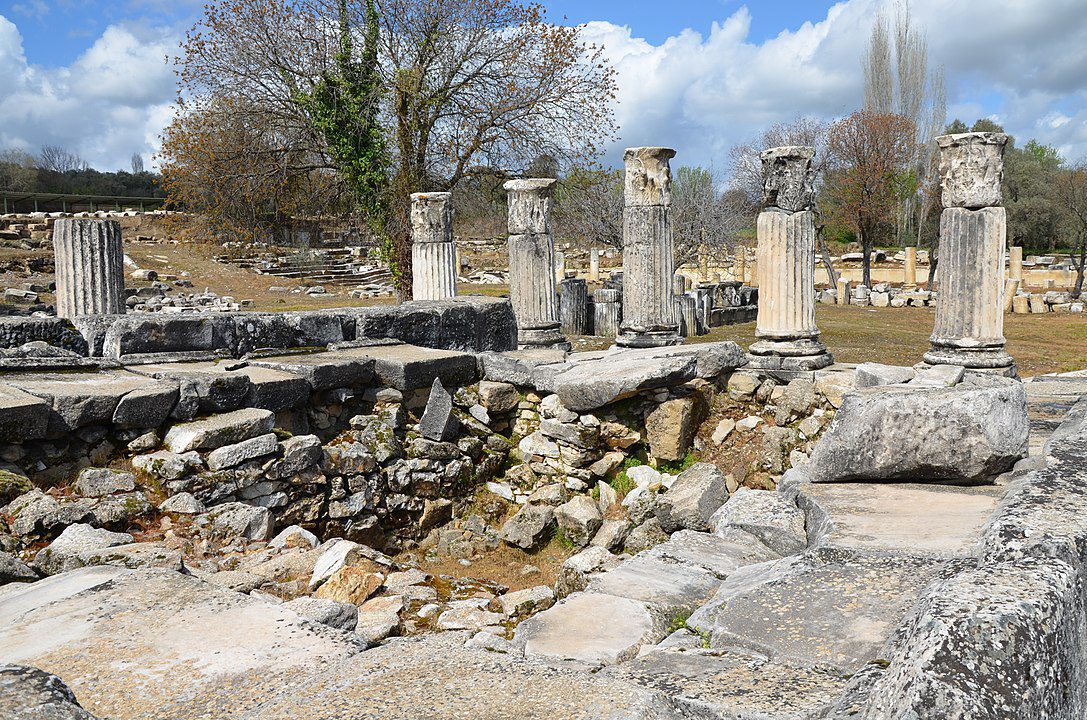
Divine duties
Hekate is bright, watches over childbirth, holds twin torches and acts as a guide. She is also called the Black Goddess and characterised as a pale goddess of the night, of witchcraft, associated with sorcery, incantations, poisons, herbs, charms, necromancy, and death magic. A chthonic goddess, Hekate guides deceased souls and is accompanied by the Lampades, nymphs of the Underworld.
Hekate is said to have three faces, three forms, and be of three ways. She becomes associated with crossroads, where people made offerings to her, as well as borders, city walls, gates, and doorways.
Hekate’s numerous epithets give us more insight into her roles and qualities. Some of her well-known titles are:
- Apotropaia (that turns away/protects)
- Chthonia (of the earth/underworld)
- Dadouchos (torch-bearer)
- Enodia (of the way)
- Kleidouchos (holding the keys)
- Kourotrophos (nurse of children)
- Krokopeplos (saffron cloaked)
- Phosphoros (bringing or bearing light)
- Propolos (who serves/attends)
- Propylaia (before the gate)
- Soteira (saviour)
- Triformis (three-formed)
- Trioditis (who frequents crossroads)
Hekate is a liminal goddess, a crosser of boundaries. Her father, Perses, is a Titan whose name means “destroyer”. Her mother is Asteria, a daughter of a Titan who inhabited Olympus and whose name means “starry one”. Asteria may also have been a goddess of dream oracles. We begin to see how the only daughter of The Destroyer and the Falling Stars inherited power over heaven, earth, and sea.
Hekate crossed the Titan and Olympian regimes, the realms between the mortal and divine, and the living and the dead. Her liminality is seen in her iconography, her many epithets, and places of worship.
What does Hekate look like?
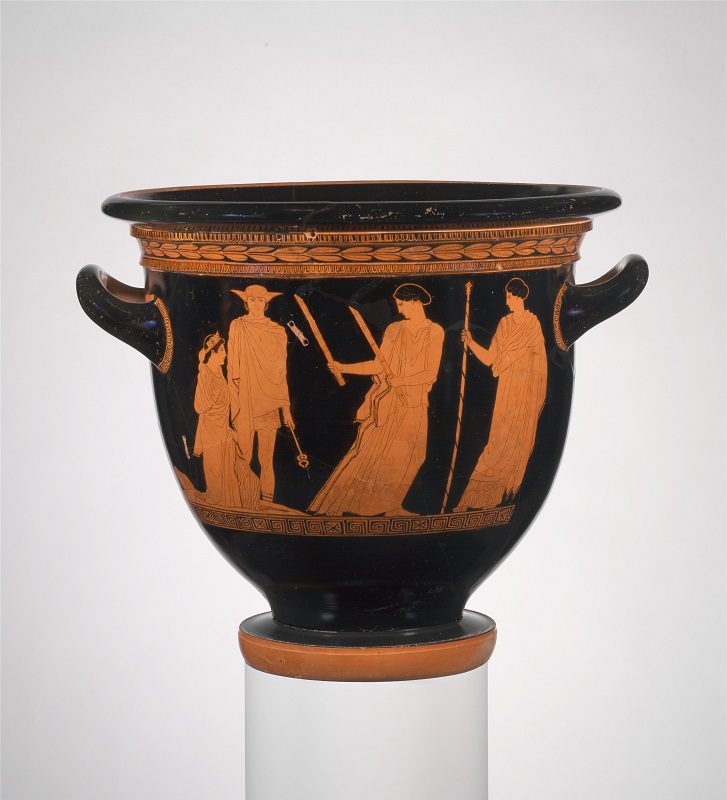

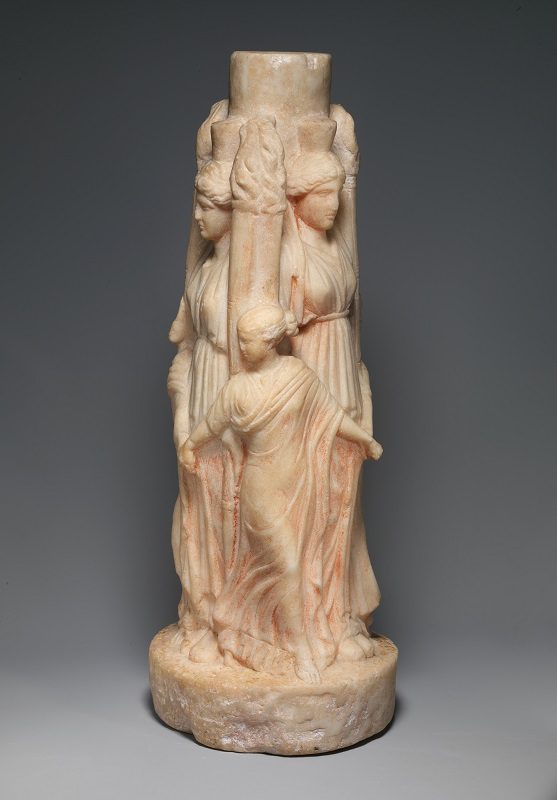
Hekate has historically been depicted as young. The so-called Running Maiden from Eleusis from about 480 BCE, identified with Hekate, wears a garment characteristic of girls. In the early 20th century, the growing association of triple goddesses with the Maiden, Mother, and Crone model led to the transformation of Hekate from young to old. This image of Hekate as Crone has persisted in contemporary Paganism.
Early depictions show Hekate in a singular form, wearing a long garment and holding burning torches. Later, she appears with three separate bodies around a central column. In late antiquity, she is singular with three heads. In esoteric literature, she has three animal heads: a dog, snake, and horse.
I see Hekate as a young woman with dark hair and a pale, olive complexion. One of my favourite depictions of her is by Carolina Mylius, shown below.
Next time, I’ll dive more deeply into some of Hekate’s divine functions and explore some approaches to her worship.
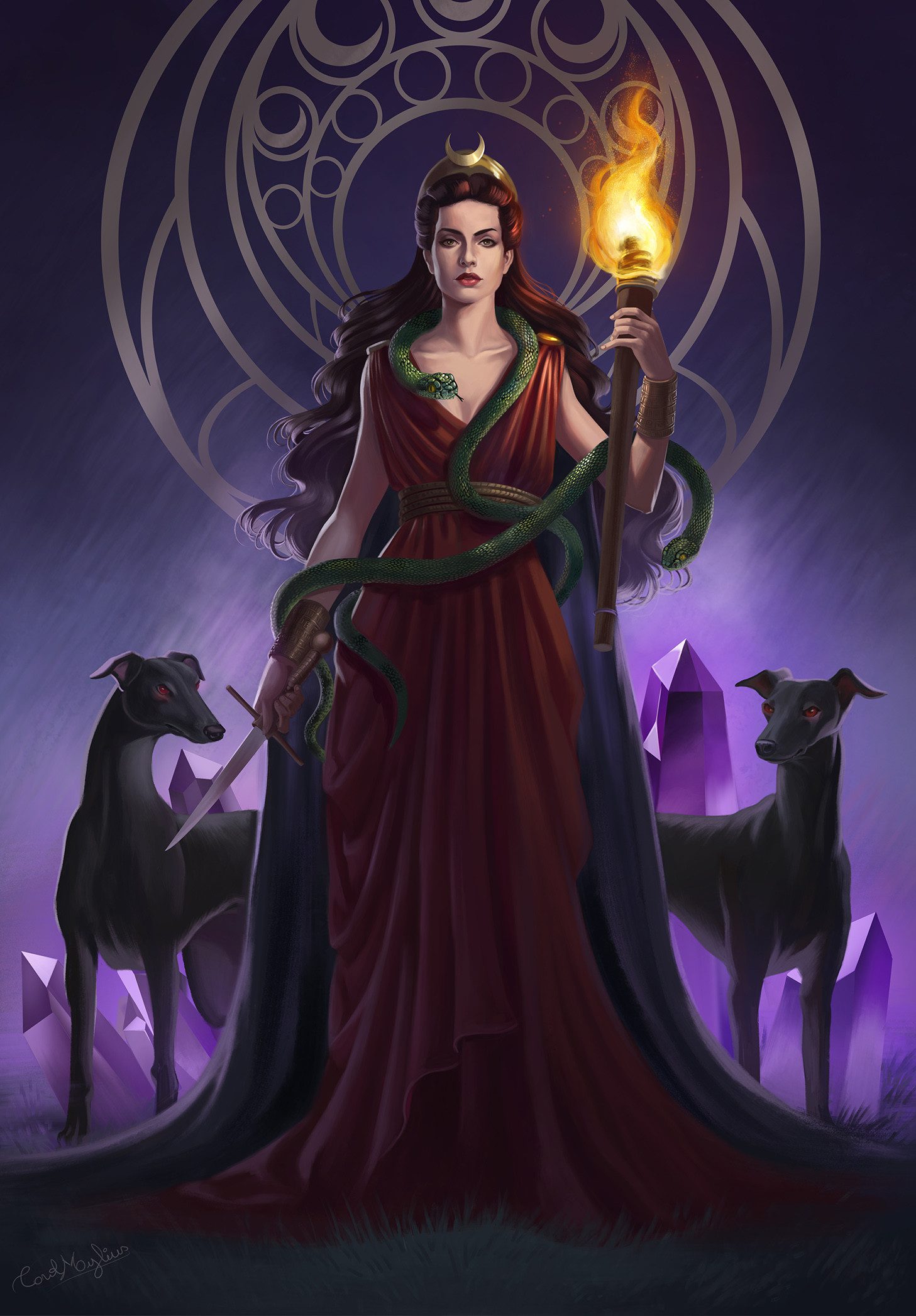

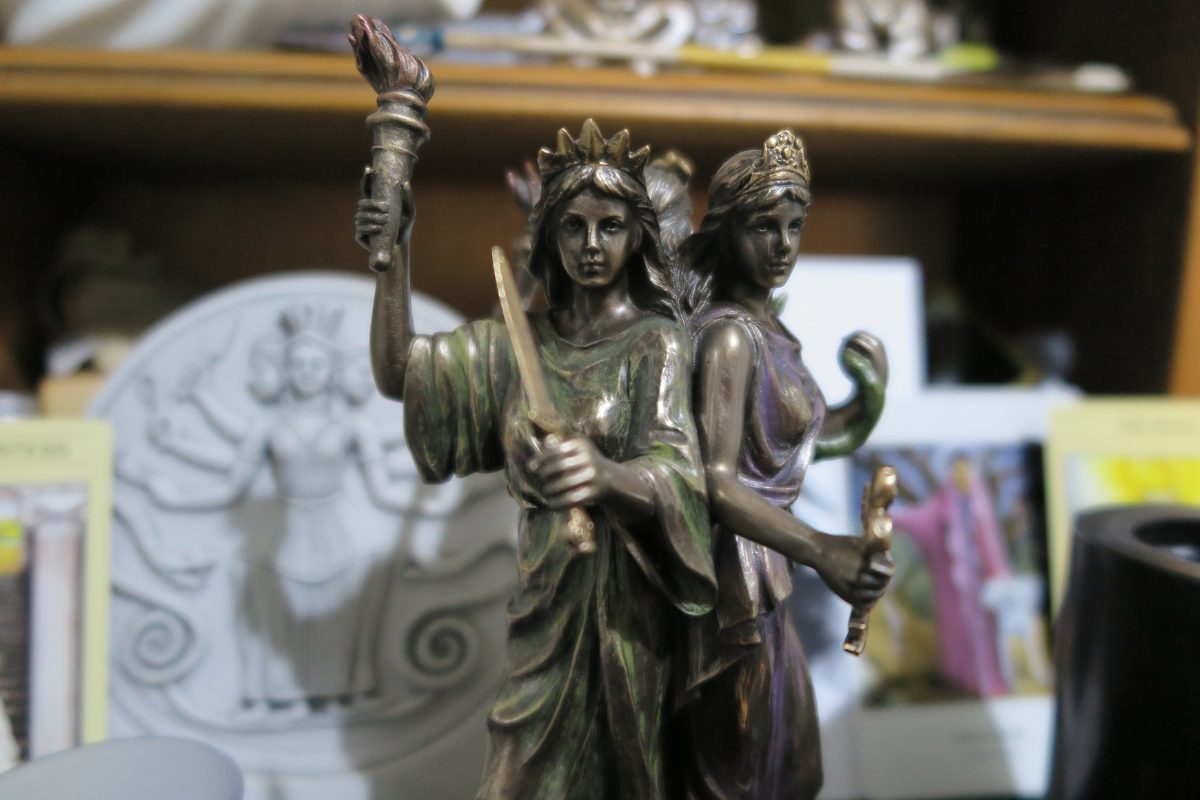
I have recently come to find whom has been calling to me, or leaving me signs to worship Her. I have always felt it was a her, and did not feel any pull towards the God most know and pray of. I’ve felt pull towards all water, and the Moon, and have seen numerous signs. A tree I was always fascinated with as a child was a split trunk and the only one of its kind I had seen in that yard, to signify crossroads. There was a hole at the bottom that looked like it had a large egg in it, the next day (or by dream) I went out to see a turquoise, yellow belly and shimmery blue and green snake staring back at me. The egg was gone the next day. Dogs have also, always been kind towards me, even ones known to be aggressive. I discovered the Goddess Hecate and have found a sense of purpose. The Mother has been leading me towards her this whole time.
I’m glad you’ve found your way to Hecate. Thanks for reading and commenting, Alex. Best of luck on your journey.
U are welcome
I know of someone who has been having strange lucid dreams where he finds himself in world of perpetual twilight. There is a woman there on a thrown of sorts and has attendants. He says there are 2 torches on the throne and there is a black dog. The man is manic and considered delusional but I took an interest in his dreams and begin trying to see if there was anything in mythology to aligned to the dreams. I focused on Haitian and African myths because of his geographical location and never uncovered anything. Today I described the dreams to an AI chatbot who immediately suggested Hecate. Mind blown. There is a lot more to the dreams but he has been having them over the last three or four years and believes they are tied to a location from his youth. I’m starting to believe that someone the world considers mentally ill is actually the opposite.
Thank you for your comment, Alan. That’s interesting and you raise an excellent question at the end. History is full of people who heard voices and experienced visions. Sometimes, we’ve accepted it as mysticism, and sometimes, we’ve called them crazy. Determining where to draw that line can be tricky, but we can look at how it affects the person. Do they welcome it or are they troubled by it? I made a video about this over on TikTok: https://www.tiktok.com/@divinehourswitch/video/7325784329466940680
I’m told I am am crazy all of the time but I feel more like I am being lead to this hekate also. I first heard of her a year ago and since looking back find a lot has been telling me to look into her more. I just did a tarot thing and was told to look into her to or call on a goddess and of course I looked her up and relate (for lack of better words) to her most. Thank you for your writing. I will be reading more. Also thank you for not jumping on the they’re just crazy and recognizing it’s something g much more than what some can begin to comprehend.
No matter how much i read or know i’m still confused or maybe blocked, lilith and hekate has been calling out to me throw dreams and such. something has been holding me back from doing my work that i need to do. i’m at a lose for words its overwhelming me its always on my mind the both of them are, i just don’t get it.
No wonder you are confused with two powerful Goddesses, Hekate and Lilith vying for your attention.
I have been a Hekatean Witch for a few years now and a good friend of mine has after a long time finally headed the call of Lilith.
I have been interested in Greek mythology from a young age and originally had Artemis and Pan as my God and Goddess in the Wiccan tradition. Hekate appeared as She often does to people when they are at a turning point, a crossroads in their lives.
My female friend answered Lilith’s call and has found her life transformed by the Goddess who refused to be subservient to Adam and transformed into a Goddess of independence and female empowerment.
It would be hard to serve both Lilith and Hekate simultaneously Lexi and perhaps study the backgrounds and history of each Goddess and find which one resonates most with your frequencies.
Blessed be.
Olá, Lexi, desde a minha adolescência eu tenho conexão com Lilith, há pouco tempo recebi o chamado de Hekate. E sim, tem como você cultuar ambas, porém preste atenção, apesar de muitas diferenças históricas, ambas tem algo em comum; esperam uma relação de parceria e respeito, nada de submissão. Não fique com medo delas, elas são sombrias – eu sei bem – rs, mas são incríveis de trabalhar. Um conselho de ouro, um altar para cada deus/deusa que for trabalhar, para você não sofrer com o choque de egrégoras. Cada uma pode ter um espaço teu, pois cada uma vai trabalhar uma missão com você. No caso de Lilith, ela trabalha muito no cósmico, então não monte altar para ela de imediato, ela atua muito em projeções astrais, “sonhos”, deixe ela te guiar a melhor forma de trabalho. Não se prenda também ao conhecimento dos outros, é importante lê-los e ouvi-los mas não é pq eles pararam ali que vc deva parar também, vá além, confie na sua intuição, ouça as deusas e tudo será clarificado.
Ave Hekate ~~~~
ave Lilith ++++
Qualquer dúvida, meu e-mail está aí!
93/93/93 “Faze o que tu queres, há de ser o todo da lei.”
I had an experience with her without knowing anything about her. (I go in cold.) I have questions, but so far all I can find is general information. Your post here helped with a bit. I have to say, though, that my experience was ages more friendly than people say to expect. So I guess I’ll desperately keep floundering.
I’m a recent disciple of Hekate-as a guy,I’ve always believed in female supremacy.Can only worship when Xtian wife goes away few days per week…After creating my altar,I left my house to walk my Black dog,passing an OWL suncatcher on a table,opening the door a new moon was peeking between the clouds! Next day I collected 3 crow feathers and crossroads soil,was wondering where to get rope for my altar,I next passed a field from whose gate a piece of rope was hanging! how can all this be chance?!!! HAIL HEKATE!
I’ve just recently realized that Hekate has been trying to get my attention for awhile now. My last sign was being drawn to a necklace with the 3 moons symbol pendant not knowing what that meant at the time. Now I’m convinced and am learning as much as I can. My altar is in the making, there’s still a couple items I’m looking for but with Hekate’s guidance I’ll find them soon!
I’m a bit confused about the pronunciation of Hekate. I’ve always pronounced it hec-cah-tay but my daughter pronounces it hah-caw-tay. Anyone?? Also I’ve seen the spelling Hecate, C or K?? Thx!
That’s wonderful! Building an altar is a wonderful way to deepen that connection, and I’m sure you’ll be guided to the right pieces in the right time.
For pronunciation, I most commonly hear “HEK-ah-tay” and “he-KAH-teh” (closer to the Greek pronunciation). As for spelling, Hecate is the Latinised form, while Hekate is closer to the Greek.
Quiero estar más de cerca a HÉCATE y para la sabiduría de sus enseñanzas.
I’m a cross-roads person – intersex – born neither male nor female with male-ish genitals but neither fertility. I am quite literally, biologically in the middle. Of course, I needed a “home base” to live in this reality-denying society so because I seemed more boy than girl by 3yrs. – boy I was and man I became with the modern invention of artificial hormones. Without them, I would have died sickly and young. Adult hormones are essential. When I was in my mid 40’s and happily “married” to another man – I am gay… I was a little concerned that there was absolutely NOTHING in my life that was female. I thought I might ask for a feminine influence in the form of a Goddess. The first image that came to mind was a middle aged Italian woman who was my first boss – in a book store. She was like the mother I never had in that she taught me a WHOLE LOT about life and business, often with a kick in the butt. I asked, “Who?” and the voice in my head replied, “Hecate” – pronounced to me as heck- oh – tay. I looked her up and lo and behold, she was an historical figure! I meditated on her with a request for a name – a “witch name”. She gave me, “Nimuel”. I have tried to find where it comes from to no avail. The only place was somewhere in the Philippines and it is not native- rather a made up variant on some thing…who knows. Well, it is mine now. I am neither religious nor a “believer” in ANYTHING. I’m an evidence and knowledge from observation kind of person, so I do not apply anything “other worldly” to this experience – just that these are my experiences and I only know as much as I know and no more. Everything is subject to change upon review, argument and more info. This may speak to others or not and that is just part of sharing. May your life be long and as pain free and pleasure filled as possible.